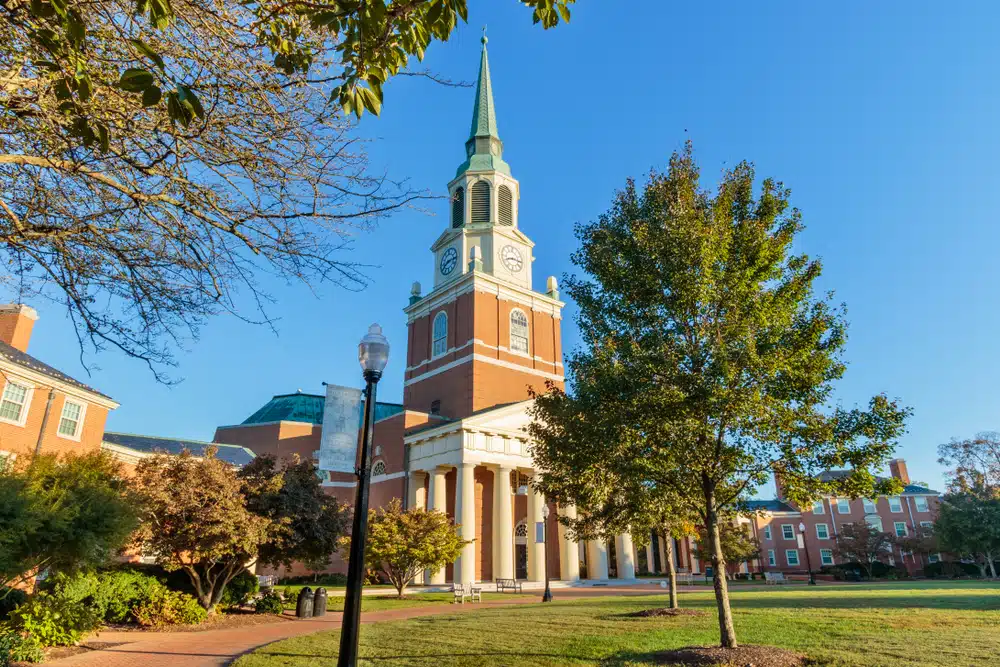Wake Forest vs Barnard: A Comprehensive Look
Choosing the right college can be an overwhelming task, with so many factors to consider. Two reputable schools that are often compared are Wake Forest University vs Barnard College. Each school offers unique opportunities for students, but which one is right for you? In this article, we will compare various aspects of both universities, including location, academic programs, cost, student life, housing, admission requirements, career services, diversity and inclusion, athletics, alumni networks, study abroad programs, faculty quality, campus safety, and student support services.
Location and Campus Atmosphere: Comparing Wake Forest and Barnard
Wake Forest is located in Winston-Salem, North Carolina, a small city with a rich cultural history. The campus is situated on 340 acres of land, and has a traditional Southern charm. This provides an intimate and close-knit community for students, with world-class amenities. Simple lifestyle and ample greenery attracts students who want to enjoy a peaceful academic experience. On the other hand, Barnard is located in the heart of New York City, surrounded by skyscrapers and an urban hustle-bustle. The proximity of Barnard to Columbia University provides more opportunities to explore academia. Many Barnard students take classes at Columbia University, while the reverse is not true.
Despite the differences in location, both Wake Forest and Barnard offer unique campus atmospheres. Wake Forest has a strong emphasis on community service and engagement, with many opportunities for students to get involved in local organizations and initiatives. The university also has a strong athletic program, with many students participating in varsity and club sports. In contrast, Barnard has a strong focus on women’s leadership and empowerment, with many resources and programs dedicated to supporting female students. The campus also has a vibrant arts scene, with many student-run theater productions and art exhibitions throughout the year.
Another notable difference between Wake Forest and Barnard is the size of the student body. Wake Forest has a total undergraduate enrollment of around 5,200 students, while Barnard has around 2,600. This means that Wake Forest offers a wider range of academic programs and extracurricular activities, while Barnard provides a more intimate and personalized learning experience. Ultimately, the choice between these two schools will depend on individual preferences and priorities, but both offer excellent opportunities for students to grow and thrive academically and personally.
Academic Programs: A Comprehensive Comparison between Wake Forest and Barnard
Wake Forest is well-known for its pre-med, business, and liberal arts programs. The school offers 42 majors, ranging from Accounting to Women’s, Gender, and Sexuality Studies. Wake Forest emphasizes a liberal arts education, whereby students are encouraged to take a wide range of courses, even outside their major, to foster critical thinking. Barnard, on the other hand, is an all-women’s liberal arts college that offers over 50 academic programs. Many of its programs revolve around the areas of humanities, social sciences, and pre-professional programs.
One unique aspect of Wake Forest’s academic programs is its emphasis on experiential learning. The school offers numerous opportunities for students to engage in hands-on learning, such as internships, research projects, and study abroad programs. These experiences allow students to apply what they have learned in the classroom to real-world situations, preparing them for their future careers. Barnard also offers experiential learning opportunities, such as internships and research projects, but its focus is more on community engagement and social justice. The college encourages students to use their education to make a positive impact on the world around them.
Cost of Attendance: Which College Offers Better Value for Your Money?
The cost of attendance can be a major factor for many students when it comes to choosing a college. Wake Forest’s tuition and fees for the 2020-2021 academic year is $59,314, while Barnard’s is $58,404. These numbers may seem steep, but both schools offer generous financial aid packages, and almost 50% of students receive need-based financial aid from Wake Forest and over 60% of students from Barnard. The difference comes in the expected contribution from the family’s side, with Wake Forest aiming at 16,000 and Barnard, at 23,773. Students from families earning under 60,000 are expected to contribute nothing at both colleges.
It’s important to note that the cost of attendance goes beyond just tuition and fees. Other factors to consider include room and board, textbooks, transportation, and personal expenses. Wake Forest estimates these additional costs to be around $17,000, while Barnard estimates them to be around $19,000. However, both schools offer various resources and opportunities for students to save money, such as work-study programs, scholarships, and discounted textbooks. It’s important for students and families to carefully consider all of these factors when making a decision about which college offers the best value for their money.
Student Life: How Wake Forest and Barnard Differ in Terms of Extracurricular Activities
Both Wake Forest and Barnard offer an array of extracurricular activities for their students. Wake Forest has more than 12 club sports, multiple intramurals, and over 200 student organizations. The school also has a thriving Greek life, with 25% of students participating in fraternities and sororities. The university also has a strong emphasis on community service and philanthropy. In contrast, Barnard has over 100 student organizations, and students can also participate in intramural sports and club sports. The school is known for its vibrant student life and an active student government that provides students with a voice in the decision-making process regarding student life.
However, one major difference between Wake Forest and Barnard is the location of the schools. Wake Forest is located in Winston-Salem, North Carolina, which offers students access to a variety of outdoor activities such as hiking and skiing. On the other hand, Barnard is located in the heart of New York City, providing students with endless opportunities to explore the city and attend cultural events. This location difference can greatly impact the types of extracurricular activities and experiences available to students at each school.
Housing Options: Comparing Dormitories, Apartments, and Off-Campus Housing at Wake Forest and Barnard
Both Wake Forest and Barnard offer various housing options for their students. Wake Forest has 15 residence halls, including living-learning communities that allow students to live with others who share similar interests. Roommate requests are also considered. Barnard provides housing for all four years of an undergraduate’s academic life, with various styles of on-campus housing, such as singles, doubles, and suites. In the senior year, students can participate in the suite selection process and choose from different apartments or communities for their housing. Students can also opt to live in buildings owned and managed by the college such as Elliot or the historic townhouses on Claremont.
Off-campus housing is also an option for students at both Wake Forest and Barnard. Wake Forest has a variety of off-campus housing options available, including apartments and houses for rent. The university also provides resources to help students find off-campus housing that meets their needs. Similarly, Barnard offers resources to help students find off-campus housing, including a database of available apartments and houses for rent in the surrounding area. However, students should be aware that living off-campus may require a longer commute to campus and may not provide the same level of support and resources as on-campus housing.
Admission Requirements: What It Takes to Get into Wake Forest and Barnard
Both Wake Forest and Barnard are selective colleges that have rigorous admission requirements. Wake Forest has an acceptance rate of 30%, while Barnard’s acceptance rate is lower at 11.3%. Both schools require students to submit high school transcripts, standardized test scores, essays, and recommendation letters. Wake Forest gives more importance to demonstrated interest as opposed to Barnard, which considers it less. However, Barnard is selective and hence requires stronger qualifications from students to gain admission. This includes a strong academic background, community involvement and achievement in other walks of life.
Additionally, both Wake Forest and Barnard have holistic admission processes, which means that they consider factors beyond just academic achievements. They also look at extracurricular activities, leadership roles, and personal qualities such as resilience, creativity, and intellectual curiosity. Wake Forest values diversity and inclusivity, and hence, they actively seek students from different backgrounds and cultures. Barnard, on the other hand, has a strong commitment to women’s education and empowerment, and hence, they seek students who share their values and mission.
Wake Forest vs Barnard: Career Services
Wake Forest and Barnard both have robust career service programs that help students prepare for life after college. Wake Forest has a comprehensive program that includes advising, career exploration, resume and cover letter writing, and interview preparation. The school boasts of a high job placement rate, with 97.5% of graduates employed or enrolled in graduate programs within six months of graduation. Barnard offers a similar range of services, including job and internship search assistance, networking events, and career fairs. Barnard graduates are known to be successful in their career paths, with 92% employed or attending graduate school within six months of graduation.
Despite the similarities in their career service programs, there are some notable differences between Wake Forest and Barnard. Wake Forest has a strong focus on connecting students with employers through on-campus recruiting events and partnerships with companies in various industries. On the other hand, Barnard emphasizes the importance of internships and encourages students to gain hands-on experience in their fields of interest. The school has partnerships with organizations in New York City, providing students with a wide range of internship opportunities.
Another difference between the two schools is the level of individualized attention provided by their career service programs. Wake Forest assigns each student a dedicated career advisor who works with them throughout their college career. Barnard, on the other hand, offers drop-in advising sessions and workshops, allowing students to receive guidance as needed. Both approaches have their benefits, and it ultimately comes down to personal preference and learning style.
Wake Forest vs Barnard: Diversity and Inclusion
Both Wake Forest and Barnard are committed to fostering a diverse and inclusive campus environment, where all students feel valued and included. Wake Forest has an Office of Diversity and Inclusion that plays an active role in ensuring the school’s policies and practices are equitable and inclusive. The school boasts of an active Multicultural Council, led by students, that promotes diversity on campus through events and programs. Barnard also has a strong commitment to diversity and inclusion, and the school has been recognized for its efforts in this area. Barnard provides resources and support to students from underrepresented groups, such as first-generation college students and students of color.
In addition to these efforts, both Wake Forest and Barnard have implemented training programs for faculty and staff to ensure they are equipped to support and engage with students from diverse backgrounds. Wake Forest offers a Diversity and Inclusion Certificate Program for faculty and staff, which provides training on topics such as unconscious bias and cultural competency. Similarly, Barnard has a Diversity, Equity, and Inclusion Training Program for faculty and staff, which includes workshops on topics such as microaggressions and inclusive teaching practices. These training programs demonstrate the schools’ commitment to creating a welcoming environment for all students, and ensuring that faculty and staff are equipped to support and engage with students from diverse backgrounds.
Wake Forest vs Barnard: Athletics Programs
Wake Forest is a Division I school and has 16 varsity sports teams that compete in the Atlantic Coast Conference (ACC). The school has top-of-the-line athletic facilities, including the newly renovated Lawrence Joel Veterans Memorial Coliseum. Wake Forest also has impressive intramural sports programs, including intramural flag football and basketball. Barnard does not have varsity sports teams, but students can participate in club and intramural sports. The school also has fitness classes and recreational activities available for students.
One of the unique aspects of Wake Forest’s athletics programs is the emphasis on student-athlete well-being. The school has a dedicated sports medicine team that provides comprehensive care to all athletes, including injury prevention, treatment, and rehabilitation. Additionally, Wake Forest has a strong academic support system for student-athletes, with resources such as tutoring and study halls to ensure they are able to balance their athletic and academic commitments.
At Barnard, the focus on athletics is more geared towards promoting a healthy and active lifestyle for all students. The school offers a variety of fitness classes, such as yoga and dance, as well as recreational activities like hiking and kayaking. Barnard also has a partnership with Columbia University, which allows students to participate in Columbia’s varsity sports teams if they meet certain requirements.
Alumni Networks: How the Alumni Associations of Wake Forest and Barnard Can Help You Build Your Career
Both Wake Forest and Barnard have active alumni associations that offer a wide range of resources and opportunities. Wake Forest’s alumni network has over 50,000 members worldwide and provides career support, networking events, and mentorship programs. The school also has a strong alumni presence in various industries, such as finance and healthcare. Barnard’s alumnae network is also active and provides career counseling, job search assistance, and networking events. The school has a large number of successful alumnae in various fields, such as media and politics.
Additionally, both alumni associations offer opportunities for alumni to give back to their respective schools. Wake Forest’s alumni association has a volunteer program that allows alumni to mentor current students, serve on advisory boards, and participate in fundraising efforts. Barnard’s alumnae association also has a volunteer program that includes opportunities to serve as class agents, reunion planners, and career advisors.
Furthermore, both alumni associations have online directories that allow alumni to connect with each other and search for job opportunities. Wake Forest’s directory includes a job board where alumni can post job openings or search for job opportunities posted by other alumni. Barnard’s directory includes a feature that allows alumni to search for other alumnae based on their industry or job title, making it easier to connect with others in their field.
Wake Forest vs Barnard: Study Abroad Programs
Studying abroad can be a transformative experience for college students, and both Wake Forest and Barnard offer robust study abroad programs. Wake Forest has partnerships with over 150 universities worldwide and offers over 70 study abroad programs in 40 countries. The school also offers a unique global experience program, where students can take a semester-long course while traveling to multiple countries. Barnard also has a comprehensive study abroad program, with over 100 programs available in over 50 countries. The school has partnerships with various universities and international organizations, such as the United Nations.
However, there are some differences between the two programs. Wake Forest’s study abroad programs tend to focus more on language immersion and cultural immersion, with many programs requiring students to take language courses while abroad. Barnard’s programs, on the other hand, offer a wider range of academic subjects, including courses in the humanities, social sciences, and natural sciences.
Another factor to consider is the level of support provided to students while abroad. Wake Forest has a dedicated study abroad office that provides pre-departure orientation, on-site support, and re-entry programming. Barnard also has a study abroad office, as well as a network of alumnae who can provide support and advice to students while abroad.
Wake Forest vs Barnard: Faculty Quality
The quality of faculty is a significant factor that can influence a student’s academic experience. Both Wake Forest and Barnard have accomplished and dedicated faculty members. Wake Forest has a student-faculty ratio of 11:1 and an average class size of 21 students. The school boasts of a high number of faculty members, who have won national awards and grants for their research and teaching. Barnard’s faculty members are also nationally recognized and include award-winning authors, scientists, and scholars. The student-faculty ratio at Barnard is 9:1, and the school has a personalized approach to education that allows students to form close relationships with their professors.
One of the unique aspects of Wake Forest’s faculty is their commitment to experiential learning. Many professors incorporate hands-on experiences into their courses, such as field trips, internships, and research projects. This approach allows students to apply what they learn in the classroom to real-world situations and gain practical skills that will benefit them in their future careers.
At Barnard, the faculty is known for their dedication to social justice and activism. Many professors are involved in community organizations and advocacy groups, and they bring this passion into their teaching. Students have the opportunity to take courses that explore issues such as race, gender, and inequality, and they are encouraged to engage in activism both on and off campus.
Wake Forest vs Barnard: Campus Safety
Campus safety is a crucial aspect of college life, and both Wake Forest and Barnard take the safety of their students seriously. Wake Forest has its police department, which is accredited by the Commission on Accreditation for Law Enforcement Agencies (CALEA). The school has various safety measures in place, including a safety escort program, emergency telephones, and safety education programs. Barnard is also committed to campus safety and has its public safety department. The school has installed security cameras, blue light emergency telephones, and a student-run shuttle service to enhance campus safety.
Wake Forest vs Barnard: Student Support Services
Both Wake Forest and Barnard offer numerous resources and services to support their students’ physical and mental health and well-being. Wake Forest has a comprehensive student health service that offers medical care, counseling services, and health education programs. The school also has a Disability Services Office, which provides support and accommodations to students with disabilities. Barnard’s Health and Wellness Center provides medical care, counseling services, and wellness programs. The school also has a Disability Services Office, which works with students to provide accommodations and support.
In conclusion, both Wake Forest and Barnard offer unique opportunities for students, and choosing the right college comes down to your individual needs and preferences. While Wake Forest offers a traditional Southern charm and robust academic programs, Barnard provides access to the resources and excitement of New York City. We hope this article has provided you with a comprehensive understanding of the similarities and differences between these two exemplary colleges, to make an informed and wise decision. Good luck!
How AdmissionSight Can Help You With College Admissions
AdmissionSight is a college consulting firm that provides personalized assistance to students throughout the college admissions process. Here are some ways that AdmissionSight can help you:
Admissions strategy: AdmissionSight can help you develop a strategic plan for your college application process. Our professional consultants can assist with identifying schools that are a good fit for your academic, extracurricular, and personal goals and help you plan and prioritize your application strategy.
Application review: AdmissionSight can review your application and provide feedback on how to improve it. We can offer suggestions on making your application stand out and highlighting your strengths and unique qualities.
Essay coaching: AdmissionSight can help you craft compelling essays that showcase your personality, goals, and achievements. We can guide you through the essay writing process and provide feedback on your drafts to help you refine your writing.
Interview preparation: AdmissionSight can provide interview coaching to help you feel confident and prepared for college interviews. Our experts can offer tips on how to present yourself professionally and how to answer common interview questions.
Extracurricular planning: AdmissionSight can help you plan and develop your extracurricular activities to make them more impactful and meaningful. We can suggest activities that align with your interests and goals and provide guidance on demonstrating your leadership and initiative.
Overall, AdmissionSight can provide valuable guidance and support throughout the college admissions process to help you maximize your chances of getting accepted into the college of your choice.
With a high success rate of over 75%, we have built a strong network in the past decade. Book an initial consultation today, free of charge!










































